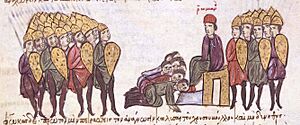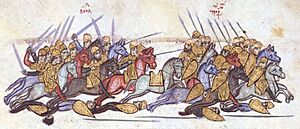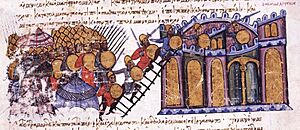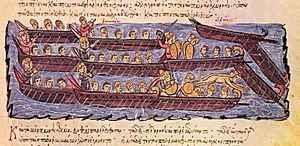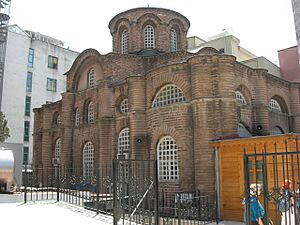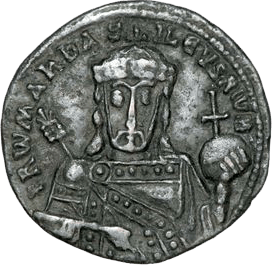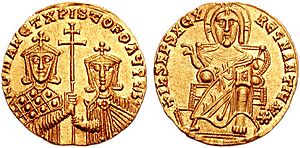Romanos I Lekapenos facts for kids
Quick facts for kids Romanos I Lekapenos |
|
|---|---|
| Emperor and Autocrat of the Romans | |
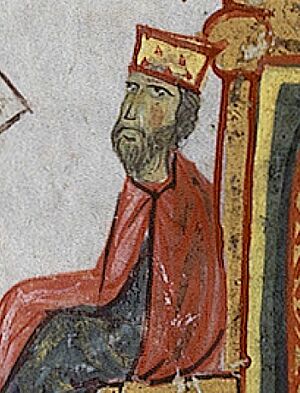
Romanos Lekapenos depicted in the 12th century Madrid Skylitzes.
|
|
| Byzantine emperor | |
| Reign | 17 December 920 – 20 December 944 |
| Predecessor | Constantine VII (under regent rule) |
| Successor | Constantine VII (alone) |
| Co-emperors | Christopher Lekapenos (921–931) Stephen Lekapenos (924–944) Constantine Lekapenos (924–944) |
| Born | c. 870 Lakape (modern-day Turkey) |
| Died | 15 June 948 (aged 77–78) |
| Burial | Myrelaion Monastery (modern-day Istanbul) |
| Consort | Theodora |
| Issue more... |
|
| Dynasty | Macedonian/Lekapenos |
| Father | Theophylaktos Abastaktos |
Romanos I Lakapenos (born around 870, died June 15, 948) was a powerful Byzantine emperor. He ruled from 920 until 944. During his time, he was a senior co-ruler and a regent for the young emperor Constantine VII.
Contents
The Early Life of Romanos I
Romanos was born in a place called Lakape, which is now in modern-day Turkey. His father, Theophylact the Unbearable, was a peasant. He was also a soldier who once saved Emperor Basil I in battle. Because of this brave act, Romanos's father was given a place in the Imperial Guard.
Romanos did not have a fancy education. But he was very good at being a soldier. He moved up in the army during the rule of Emperor Leo VI the Wise. By 911, he was a general in charge of the navy in the Samos area. Later, he became the admiral of the entire fleet.
In 917, the Byzantine army suffered a terrible defeat against the Bulgarians. After this, Romanos sailed to Constantinople. He slowly took control from the empress who was ruling at the time, Zoe Karvounopsina.
How Romanos Became Emperor
On March 25, 919, Romanos used his fleet to take over the Boukoleon Palace. This is how he took control of the government. At first, he was given important titles like magistros. But he quickly made his position stronger.
In April 919, his daughter Helena married Emperor Constantine VII. Romanos then received the special title of basileopator, which means "father of the emperor." On September 24, 920, he was named caesar. Finally, on December 17, Romanos was crowned the senior emperor.
In the years that followed, Romanos made his own sons co-emperors. These included Christopher in 921, and Stephen and Constantine in 924. Even with his sons as co-emperors, Constantine VII was still seen as the second most important ruler after Romanos. Romanos was known as "the gentle usurper" because he did not harm Constantine VII.
Romanos also made his family stronger by marrying his daughters into powerful families. He also brought back the church leader Nicholas Mystikos who had been removed. This helped end a conflict with the Papacy (the Pope) about Emperor Leo VI's marriages.
Peace with Bulgaria
One of the biggest problems Romanos faced was the war with Bulgaria. This war had started again before he took power. The Bulgarian ruler, Simeon I of Bulgaria, wanted to make a marriage alliance with Constantine VII. But Romanos stopped these plans. He did not want to give Simeon the special title of emperor that he wanted.
For the first four years of Romanos's rule, there was fighting with Bulgaria. Simeon was often winning, but he could not break through the strong walls of Constantinople. In 924, Simeon blocked the capital again. Romanos managed to start talks with him.
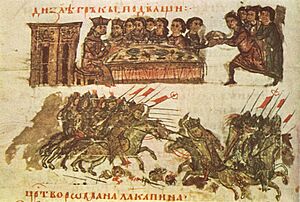
Romanos met Simeon in person. He told Simeon that he should respect Christian traditions. This meeting helped them agree to terms and Simeon lifted the siege. Romanos also quietly recognized Simeon as the emperor of Bulgaria.
When Simeon died in May 927, Bulgaria's new emperor, Peter I, wanted lasting peace. Romanos quickly suggested a marriage between the royal families of Byzantium and Bulgaria. Peter I married Maria, Romanos's granddaughter, who was renamed Eirene (meaning "Peace"). This marriage brought peace between Byzantium and Bulgaria for 40 years.
Battles in the East
Romanos chose a very skilled general named John Kourkouas to lead the armies in the East. John Kourkouas stopped a rebellion and helped in Armenia in 924. From 926, Kourkouas fought against the Abbasids (a Muslim empire) and their allies. He won an important victory at Melitene in 934. Taking this city back was a big step for the Byzantines. It was the first major land they got back from the Muslims.
In 941, most of the army was in the East. A fleet of 15 old ships had to defend Constantinople from a raid by the Kievan Rus' (people from what is now Ukraine and Russia). The Byzantines defeated the invaders at sea using Greek fire. They also defeated them on land when the army returned. In 944, Romanos made a peace treaty with Prince Igor of Kiev.
After this danger passed, Kourkouas went back to the eastern border. In 943, he attacked northern Mesopotamia. He surrounded the important city of Edessa in 944. To make him leave, Edessa gave Kourkouas a very special religious item called the mandylion. This was a holy cloth believed to have been sent by Jesus Christ.
John Kourkouas was a great general. He was removed from his position after Romanos lost power in 945. But his battles in the East helped prepare the way for even more land to be taken back later in the 10th century.
Romanos's Internal Policies
Romanos I wanted to make the Byzantine Empire stronger. He tried to make peace wherever he could. This included his dealings with Bulgaria and the Kievan Rus'. To protect Byzantine land from attacks by the Magyars (Hungarian people), Romanos paid them money and used diplomacy.
Romanos also brought peace back to the church. He settled a conflict between Rome and Constantinople in 920. In 933, Romanos made his young son, Theophylaktos, the leader of the church in Constantinople.
Romanos was also a lawmaker. He created laws to protect small landowners. These laws stopped powerful nobles from buying up all the small farms. He also increased taxes on the rich and made the government's money situation more stable. Romanos also stopped rebellions in different parts of the empire.
He added the Armenian fortress of Citharizum to the empire in 942. He renamed it Romanopolis. In Constantinople, he built his palace near the Sea of Marmara. Next to it, he built a church which became the first private burial place for a Byzantine emperor.
The End of Romanos's Reign
Later in his rule, Romanos became very interested in religion. He felt guilty for taking the throne from Constantine VII. When his most capable son, Christopher, died in 931, Romanos did not promote his younger sons over Constantine VII.
His younger sons, Stephen and Constantine, feared that Romanos would let Constantine VII become the next emperor instead of them. So, on December 20, 944, they arrested their father. They took him to the Princes' Islands and forced him to become a monk.
However, when Stephen and Constantine then threatened Constantine VII's position, the people of Constantinople revolted. Stephen and Constantine were also removed from their imperial rank and sent away to live like their father. Romanos died on June 15, 948. He was buried in the church he built, Myrelaion.
Constantine VII had lived under the threat of the Lekapenos family for a long time. He was very angry with them. In a book he wrote for his son, Constantine VII described Romanos as "an uneducated man." He said Romanos was "not raised in the high imperial manner" and was "rude and bossy."
Family Life
Romanos I's wife was Theodora, who died in 922. He had at least eight children who were considered legitimate. He also had at least one child born outside of marriage. His family connections were very important. Many powerful people in the Byzantine Empire for the next hundred years were related to him.
Some of his notable children included:
- Christopher: His oldest son and co-emperor.
- Theophylaktos: His son who became the leader of the church in Constantinople.
- Stephen and Constantine: His sons who became co-emperors but later removed him from power.
- Helena: His daughter who married Emperor Constantine VII.
- Basil: His illegitimate son, who became a very influential person in the court.
Images for kids
-
Arslan Hane, Istanbul
A chapel devoted to Christ Chalkites near the Chalke Gate, the monumental entrance to the Great Palace.
See also
 In Spanish: Romano I para niños
In Spanish: Romano I para niños


